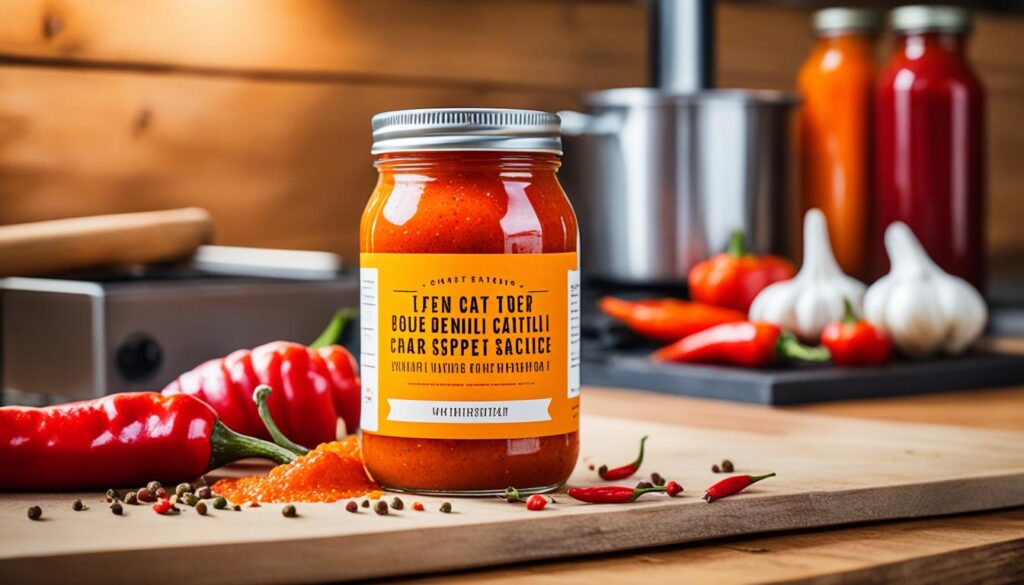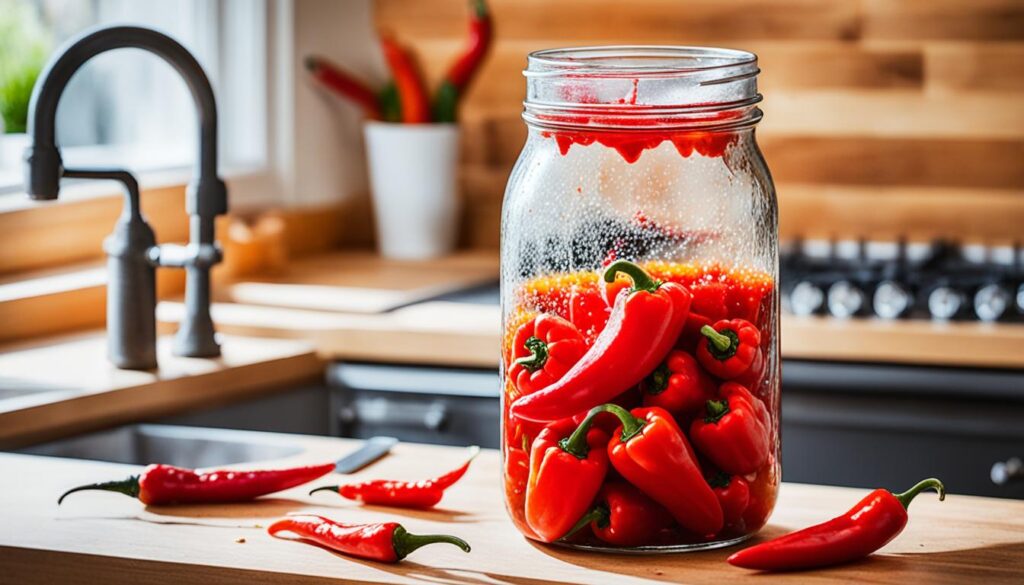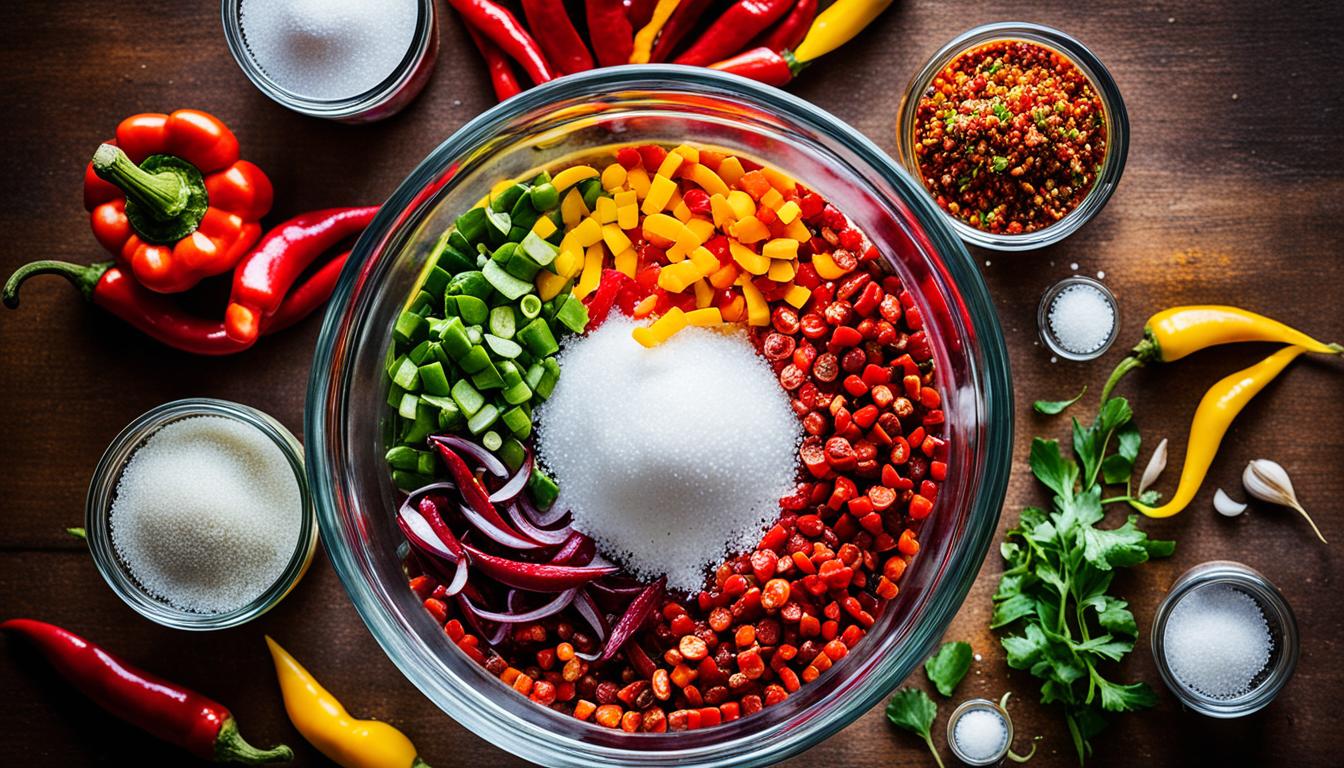Welcome to our quick guide on making your own fermented hot sauce! If you love the zesty kick of hot sauce and want to add a probiotic boost to your meals, then this DIY fermented hot sauce recipe is perfect for you. With just a few simple steps, you can create your very own homemade fermented hot sauce that is bursting with flavor and good-for-your-gut probiotics. So let’s dive in and learn how to make your very own batch of delicious fermented hot sauce!
But first, let’s take a moment to appreciate the mouthwatering possibilities. Just imagine drizzling this homemade fermented hot sauce over your favorite tacos, burgers, or even scrambled eggs. The tangy and slightly spicy flavor will elevate any dish to new heights. And the best part? You have complete control over the ingredients, ensuring that your hot sauce is tailored to your taste preferences.
In this guide, we will walk through the basics of fermented hot sauce, including the fermentation process, selecting the right peppers, and adding additional ingredients for extra flavor. We’ll also discuss the equipment and ingredients you’ll need to get started, as well as provide some inspiration for creating your own unique variations. So get ready to embark on a flavorful journey as we show you how to make your very own fermented hot sauce from scratch!
The Basics of Fermented Hot Sauce
Fermented hot sauce is created through the process of lacto-fermentation, which involves the natural breakdown of organic materials by beneficial bacteria. The peppers used in hot sauce fermentation are rich in sugars that lactic acid bacteria consume, resulting in a lower pH and the preservation of the sauce. This process creates a unique flavor profile and allows for the development of complex and spicy flavors.
The best recipe for fermented hot sauce involves a suitable combination of peppers, salt, water, and additional ingredients for flavor. By carefully selecting the peppers, you can determine the level of spiciness and add depth to the sauce. It’s important to balance the heat with other flavors, such as tangy ingredients like vinegar or citrus juice, to create a well-rounded hot sauce. Experimentation is key, and you can customize the recipe to suit your taste preferences.
During the fermentation process, the peppers undergo a transformation as the bacteria feed on the sugars and produce lactic acid. This acidity not only enhances the flavor but also acts as a natural preservative. It’s important to note that the fermentation process takes time, usually around 1-2 weeks, and during this period, you’ll need to care for the sauce by stirring it occasionally and monitoring its progress.
“Fermenting hot sauce allows the flavors to develop and intensify over time, resulting in a rich and complex taste that you won’t find in store-bought sauces.”
Fermented hot sauce is a versatile condiment that can complement a wide range of dishes. Whether you’re adding a kick to tacos, soups, or even scrambled eggs, homemade fermented hot sauce adds a burst of flavor that elevates any meal. Plus, it’s packed with beneficial probiotics that can support a healthy gut.
Spicy Fermented Hot Sauce Recipe
If you’re looking for a simple and delicious fermented hot sauce recipe, here’s one to get you started:
- Ingredients:
- 2 cups hot peppers (such as jalapenos or habaneros), chopped
- 3 cloves garlic, minced
- 2 teaspoons sea salt
- 2 cups filtered water
- Optional: 1 tablespoon apple cider vinegar or lime juice
- In a glass jar, combine the chopped hot peppers, minced garlic, sea salt, and filtered water. Stir well to dissolve the salt.
- Cover the jar with a breathable cloth or plastic wrap secured with a rubber band.
- Place the jar in a cool, dark area, away from direct sunlight.
- Let the mixture ferment for 1-2 weeks, stirring daily to prevent mold formation.
- After the desired fermentation time, blend the mixture using a blender or immersion blender until smooth.
- Optional: Add apple cider vinegar or lime juice for extra tanginess.
- Transfer the hot sauce to a sealed bottle or jar and refrigerate for up to 6 months.
Feel free to adjust the quantities of ingredients to suit your taste preferences. You can also experiment with different types of peppers or add other spices and herbs to create your own signature spicy fermented hot sauce.

Getting Started with Fermentation
To begin fermenting your own hot sauce at home, there are a few basic materials and ingredients you’ll need. Let’s walk through the steps together.
Gather Your Supplies
First, you’ll need glass jars for fermentation. These are ideal for creating the perfect environment for the fermentation process. Additionally, consider using airlock lids to create an anaerobic environment, enabling the growth of beneficial bacteria.

Choose Your Peppers
Next, select the hot peppers that you want to use for your hot sauce. Whether you prefer habaneros, jalapenos, or any other variety, make sure they are fresh and free from any signs of rot or mold.
Prepare the Ingredients
In addition to the hot peppers, you’ll need salt and filtered water. It’s important to weigh your peppers and other ingredients to ensure the correct salt-to-pepper ratio. This will help in achieving the desired flavor and balance in your hot sauce.
Start the Fermentation Process
Place the peppers in the glass jars and cover them with the saltwater brine. Make sure all the peppers are completely submerged to prevent any mold growth. Seal the jars with the airlock lids to create an optimal fermentation environment.
Monitor and Adjust
During the fermentation process, which typically takes around 3-4 weeks, it’s important to monitor the peppers for any signs of spoilage, such as excessive mold growth or off smells. Additionally, check the pH level periodically to ensure the desired acidity is achieved. If needed, you can adjust the pH by adding a small amount of vinegar to the mixture, which can also increase the shelf stability of your hot sauce.
Now that you know the basics of fermenting hot peppers at home, you’re ready to embark on your probiotic hot sauce recipe journey. In the next section, we’ll explore different flavor variations and recipe ideas to help you create your own unique and delicious fermented hot sauces.
Flavor Variations and Recipe Ideas
Once you have mastered the basic process of fermenting hot sauce, you can experiment with different flavors and ingredients to create your own unique recipes. The fermentation process allows for the development of complex and interesting flavors, so don’t be afraid to get creative with your hot sauce recipes. Here are some ideas to inspire you:
Louisiana-Style Hot Sauce
“Louisiana-style fermented hot sauces are a popular choice, known for their smooth and slightly viscous texture.”
For a classic Louisiana-style hot sauce, try using a combination of cayenne, tabasco, and jalapeno peppers. This blend will give your sauce a vibrant red color and a medium level of heat. Add a touch of garlic and onion for extra flavor, and a hint of vinegar to balance the acidity. The result will be a tangy and flavorful hot sauce that pairs perfectly with seafood, gumbo, or jambalaya.
Mexican-Style Hot Sauce
“Mexican-style sauces are a blend of different pepper types and have a thicker consistency.”
To create a Mexican-inspired hot sauce, mix together a variety of peppers, such as serrano, habanero, and poblano. This combination will give your sauce a fiery kick and a rich, earthy flavor. Add some fresh lime juice and cilantro for a bright and zesty twist. This versatile hot sauce is perfect for tacos, enchiladas, or any dish that needs a burst of heat and flavor.
Customized Creations
Don’t be afraid to experiment and create your own hot sauce variations. Try adding unique ingredients like fruits (mango, pineapple), herbs (basil, cilantro), or spices (cumin, paprika) to add depth and complexity to your hot sauce. You can also adjust the heat level by using milder or hotter peppers, depending on your preference.
Remember to taste and adjust the flavors as you go, and don’t be afraid to make changes to suit your palate. The beauty of homemade hot sauce is that you can customize it to your liking and create a truly one-of-a-kind condiment.
With these flavor variations and recipe ideas, you can take your homemade fermented hot sauce to the next level. Whether you prefer a tangy Louisiana-style sauce or a fiery Mexican-inspired blend, the possibilities are endless. So grab your peppers, get fermenting, and enjoy the delicious and spicy world of homemade fermented hot sauce.
Storing and Enjoying Your Fermented Hot Sauce
Once your homemade fermented hot sauce is ready, it’s important to know how to properly store and enjoy it. Keeping the sauce in the refrigerator will help maintain its freshness and extend its shelf life for several months. While the fermentation process slows down in cold temperatures, it can continue at room temperature, which is why refrigeration is crucial.
If you prefer a smoother texture, you can strain the hot sauce to remove any solids and create a more refined consistency. Simply pour the sauce through a fine-mesh strainer or cheesecloth to achieve the desired smoothness. This step is optional, but it can enhance the overall enjoyment of your fermentation process hot sauce.
To ensure the flavor and freshness of your homemade hot sauce, it’s recommended to bottle it in sealed containers. This helps to preserve the taste and prevent any contamination. Mason jars or glass bottles with airtight lids work well for storing fermented hot sauce. Make sure the containers are clean and dry before transferring the sauce into them.
Now that you have your flavorful homemade fermented hot sauce, it’s time to savor it! Drizzle it over your favorite dishes, whether it’s tacos, eggs, pizza, or grilled meats. The tangy and spicy kick from the hot sauce will add a burst of flavor to every bite. Enjoy the probiotic goodness and the unique taste that comes from the fermentation process. Get creative and experiment with different dishes to find the perfect pairing for your homemade fermented hot sauce.
